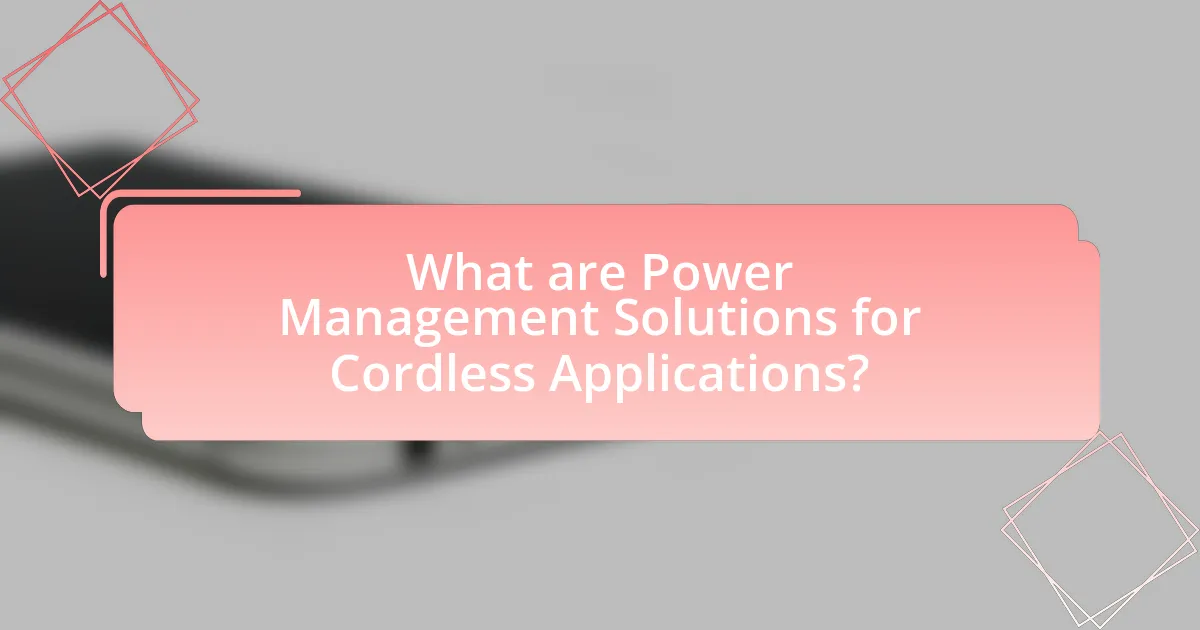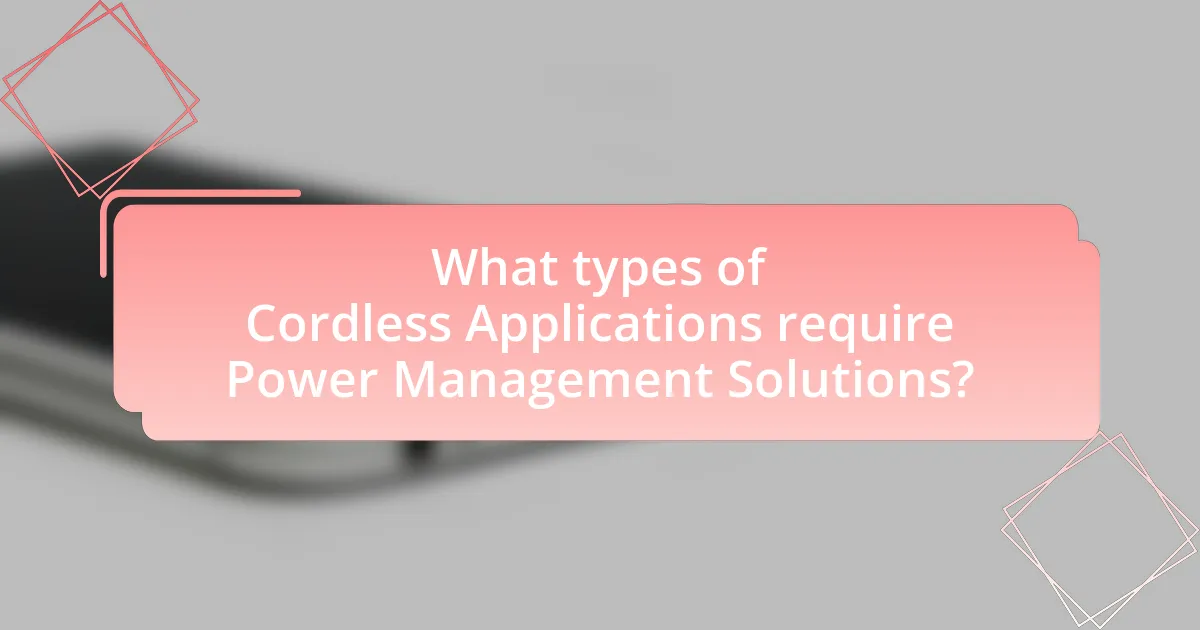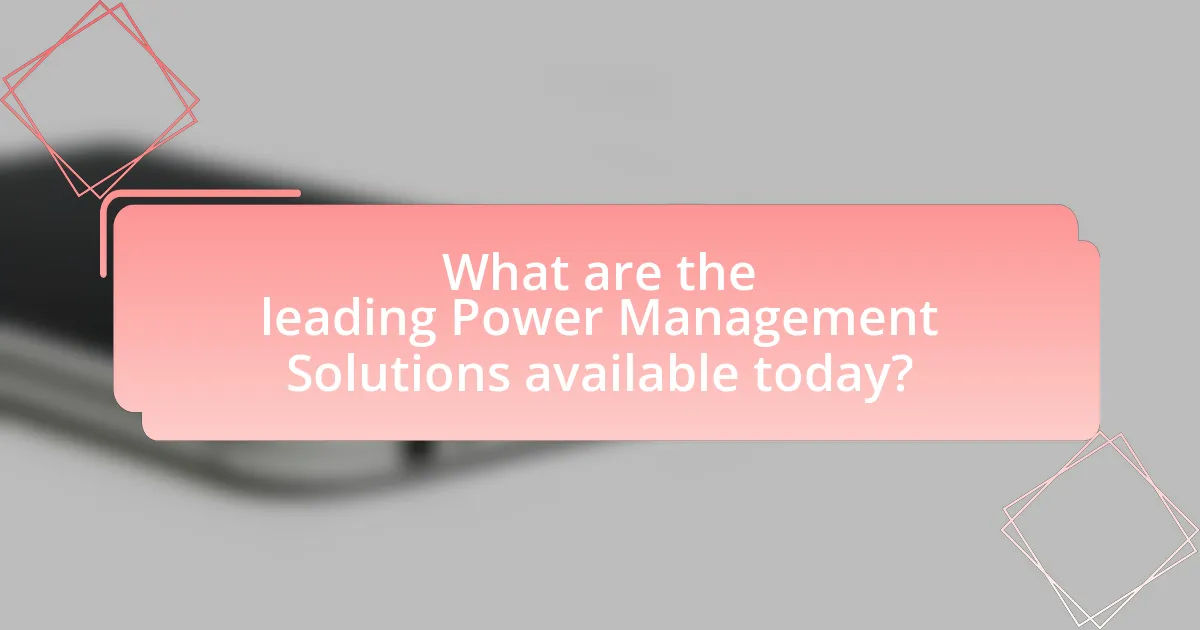Power management solutions for cordless applications are critical systems designed to enhance energy efficiency and extend battery life in battery-operated devices. This article examines various power management techniques, including dynamic voltage scaling, power gating, and energy harvesting, highlighting their impact on performance and longevity across different applications such as consumer electronics, industrial tools, and medical devices. Key components of these solutions, such as battery management systems and energy harvesting technologies, are discussed, along with the importance of comparing different solutions based on efficiency, cost, and compatibility. Additionally, the article addresses the challenges of implementing these solutions and offers best practices for selecting the most suitable power management systems for specific needs.

What are Power Management Solutions for Cordless Applications?
Power management solutions for cordless applications are systems designed to optimize the energy consumption and efficiency of battery-operated devices. These solutions include techniques such as dynamic voltage scaling, power gating, and energy harvesting, which help extend battery life and improve performance. For instance, dynamic voltage scaling adjusts the voltage supplied to the processor based on workload, reducing energy consumption during low-demand periods. Additionally, power gating turns off unused components to minimize energy waste. According to a study by the IEEE, implementing these power management strategies can lead to energy savings of up to 30% in portable devices, demonstrating their effectiveness in enhancing the longevity and functionality of cordless applications.
How do Power Management Solutions impact cordless devices?
Power Management Solutions significantly enhance the performance and efficiency of cordless devices by optimizing energy consumption and extending battery life. These solutions employ techniques such as dynamic voltage scaling, sleep mode management, and energy harvesting, which collectively reduce power usage during idle periods and adapt energy supply based on operational demands. For instance, a study by the IEEE on energy-efficient designs in wireless sensor networks demonstrated that implementing advanced power management techniques can lead to a 30% increase in battery longevity. This optimization not only improves user experience by reducing the frequency of recharging but also contributes to the overall sustainability of cordless technologies.
What are the key components of Power Management Solutions?
The key components of Power Management Solutions include voltage regulation, battery management systems, energy harvesting technologies, and power distribution networks. Voltage regulation ensures that devices receive a consistent voltage level, which is crucial for optimal performance. Battery management systems monitor and control battery charging and discharging, enhancing battery life and safety. Energy harvesting technologies capture and convert ambient energy into usable power, reducing reliance on traditional power sources. Power distribution networks efficiently distribute power to various components within a system, ensuring reliability and performance. These components collectively enhance the efficiency and effectiveness of power management in cordless applications.
How do these components interact within cordless applications?
In cordless applications, components such as batteries, power management circuits, and load devices interact to optimize energy efficiency and performance. The battery supplies energy, while power management circuits regulate voltage and current to ensure that the load devices operate within their specified parameters. This interaction is crucial for extending battery life and enhancing the overall functionality of the cordless application. For instance, efficient power management can reduce energy waste by dynamically adjusting power delivery based on the load’s requirements, which is supported by studies showing that optimized power management can improve battery life by up to 30%.
Why is it important to compare different Power Management Solutions?
Comparing different Power Management Solutions is crucial because it enables the identification of the most efficient and cost-effective options for specific applications. Different solutions can vary significantly in terms of energy efficiency, performance, and compatibility with various devices. For instance, a study by the International Energy Agency found that optimizing power management can reduce energy consumption in electronic devices by up to 30%. This highlights the importance of evaluating multiple solutions to ensure optimal performance and sustainability in cordless applications.
What criteria should be used for comparison?
The criteria for comparison of power management solutions for different cordless applications should include efficiency, cost, compatibility, scalability, and performance. Efficiency measures how effectively the solution utilizes energy, which is crucial for battery-operated devices. Cost involves both initial investment and long-term operational expenses, impacting overall feasibility. Compatibility assesses how well the solution integrates with existing systems and technologies, ensuring seamless operation. Scalability evaluates the solution’s ability to adapt to varying power demands as applications evolve. Performance focuses on the reliability and responsiveness of the power management system under different load conditions. These criteria are essential for making informed decisions in selecting the most suitable power management solution for specific cordless applications.
How do different solutions affect performance and efficiency?
Different power management solutions significantly impact performance and efficiency in cordless applications by optimizing energy consumption and extending operational time. For instance, advanced solutions like dynamic voltage scaling and adaptive power control can reduce energy waste, leading to longer battery life and improved device responsiveness. Research indicates that implementing these strategies can enhance efficiency by up to 30%, as demonstrated in studies on battery-operated devices where optimized power management resulted in a notable increase in runtime without compromising performance.

What types of Cordless Applications require Power Management Solutions?
Cordless applications that require power management solutions include power tools, consumer electronics, medical devices, and electric vehicles. These applications depend on efficient energy usage to enhance performance and extend battery life. For instance, power tools like cordless drills and saws utilize power management to optimize battery discharge rates, ensuring longer operational times. Similarly, consumer electronics such as smartphones and laptops implement power management to balance performance and energy consumption, which is crucial for user satisfaction. Medical devices, including portable monitors and infusion pumps, rely on power management to ensure reliability and safety during operation. Electric vehicles utilize sophisticated power management systems to maximize range and efficiency, demonstrating the critical need for effective power management across various cordless applications.
How do Power Management Solutions vary across different applications?
Power management solutions vary significantly across different applications due to the specific energy requirements and operational contexts of each application. For instance, in consumer electronics, power management focuses on maximizing battery life and efficiency, often utilizing techniques like dynamic voltage scaling and sleep modes. In contrast, industrial applications may prioritize reliability and robustness, employing solutions that ensure consistent power supply and fault tolerance, such as uninterruptible power supplies (UPS) and power distribution units (PDUs). Additionally, automotive applications require power management systems that can handle high power demands and thermal management, integrating advanced battery management systems to optimize performance and safety. These variations are driven by the distinct operational needs, performance criteria, and environmental conditions associated with each application, demonstrating that power management solutions must be tailored to meet specific demands effectively.
What are the specific needs of consumer electronics?
The specific needs of consumer electronics include efficient power management, user-friendly interfaces, and reliable connectivity. Efficient power management is crucial as it directly impacts battery life and device performance; for instance, devices like smartphones require advanced battery technologies to support high-performance applications while maintaining longevity. User-friendly interfaces enhance consumer experience, making devices intuitive and accessible, which is essential for widespread adoption. Reliable connectivity, such as Wi-Fi and Bluetooth, is necessary for seamless integration with other devices and services, ensuring that consumer electronics can operate effectively in a connected ecosystem.
How do industrial cordless tools differ in power management needs?
Industrial cordless tools differ in power management needs primarily due to their varying power requirements and operational demands. These tools, such as drills, saws, and impact wrenches, often require higher voltage and current to perform effectively in demanding environments, leading to a need for advanced battery management systems that can handle rapid discharge and recharge cycles. For instance, tools used in heavy-duty applications may utilize lithium-ion batteries with sophisticated power management features to optimize performance and extend battery life, while lighter-duty tools may rely on simpler power management solutions. This distinction is crucial as it ensures that industrial cordless tools maintain efficiency and reliability during prolonged use, which is supported by the fact that tools designed for high torque applications typically require batteries with higher capacity and advanced thermal management to prevent overheating.
What role do environmental factors play in Power Management Solutions?
Environmental factors significantly influence Power Management Solutions by determining energy efficiency, operational reliability, and system design. For instance, temperature variations can affect battery performance and lifespan, necessitating adaptive management strategies to optimize energy use. Additionally, humidity levels can impact electronic components, leading to potential failures if not properly managed. Research indicates that systems designed with environmental considerations can achieve up to 30% greater efficiency in energy consumption, highlighting the critical role these factors play in enhancing the effectiveness of power management in various cordless applications.
How does temperature affect battery performance in cordless applications?
Temperature significantly impacts battery performance in cordless applications by affecting both capacity and discharge rates. At elevated temperatures, batteries may experience increased self-discharge rates and reduced lifespan due to accelerated chemical reactions. Conversely, low temperatures can lead to decreased capacity and sluggish discharge rates, as the electrolyte becomes less conductive. Research indicates that lithium-ion batteries, commonly used in cordless devices, can lose up to 20% of their capacity at temperatures below 0°C and may overheat and degrade at temperatures above 45°C. This temperature sensitivity necessitates effective thermal management strategies to optimize battery performance in various cordless applications.
What are the implications of usage patterns on power management?
Usage patterns significantly influence power management by determining the energy consumption profiles of devices. For instance, devices that experience high usage during peak hours require more efficient power management strategies to optimize battery life and reduce energy costs. Research indicates that understanding these patterns allows for the implementation of adaptive power management techniques, which can lead to a reduction in energy waste by up to 30% in certain applications. This efficiency is crucial in cordless applications, where battery longevity directly impacts usability and user satisfaction.

What are the leading Power Management Solutions available today?
The leading Power Management Solutions available today include Texas Instruments’ Power Management Integrated Circuits (PMICs), Analog Devices’ power management solutions, and Infineon’s power management ICs. Texas Instruments offers a wide range of PMICs that optimize power efficiency and battery life in various applications, evidenced by their extensive use in consumer electronics and automotive sectors. Analog Devices provides advanced power management solutions that enhance performance in industrial and communication systems, supported by their innovative technologies like the LTC series. Infineon specializes in power management solutions that cater to automotive and industrial applications, with a focus on energy efficiency and reliability, as demonstrated by their CoolMOS and OptiMOS technologies. These companies are recognized for their contributions to improving energy efficiency and performance in cordless applications.
How do these solutions compare in terms of technology and features?
The power management solutions for different cordless applications vary significantly in technology and features. For instance, some solutions utilize advanced lithium-ion battery technology, which offers higher energy density and longer cycle life compared to traditional nickel-cadmium batteries. Additionally, features such as smart charging capabilities and integrated battery management systems enhance efficiency and safety, allowing for real-time monitoring of battery health and performance. These advancements are supported by data indicating that lithium-ion batteries can provide up to 40% more energy per weight than their predecessors, making them more suitable for modern cordless applications.
What are the advantages of using advanced battery management systems?
Advanced battery management systems (BMS) enhance the performance, safety, and longevity of battery packs. These systems optimize charging and discharging processes, ensuring efficient energy use and preventing overcharging or deep discharging, which can damage batteries. Additionally, advanced BMS provide real-time monitoring of battery health, temperature, and voltage, allowing for proactive maintenance and reducing the risk of thermal runaway incidents. According to a study by the National Renewable Energy Laboratory, effective BMS can increase battery lifespan by up to 30%, demonstrating their critical role in maximizing battery efficiency and reliability in various cordless applications.
How do energy harvesting technologies enhance cordless applications?
Energy harvesting technologies enhance cordless applications by enabling devices to capture and utilize ambient energy sources, such as solar, thermal, or kinetic energy, for power. This capability reduces reliance on traditional batteries, leading to longer operational lifespans and lower maintenance costs. For instance, a study published in the journal “Renewable and Sustainable Energy Reviews” highlights that energy harvesting can extend the life of wireless sensor networks by up to 10 years, significantly decreasing the need for battery replacements. By integrating energy harvesting, cordless applications become more sustainable and efficient, ultimately improving user experience and reducing environmental impact.
What are the challenges faced when implementing Power Management Solutions?
Implementing Power Management Solutions faces several challenges, including integration complexity, cost constraints, and varying application requirements. Integration complexity arises from the need to align new power management systems with existing infrastructure, which can lead to compatibility issues. Cost constraints often limit the adoption of advanced solutions, as organizations must balance investment with expected returns. Additionally, varying application requirements necessitate customized solutions, complicating the implementation process further. These challenges are supported by industry reports indicating that 70% of organizations cite integration as a significant barrier to effective power management.
What common issues arise during the integration of these solutions?
Common issues that arise during the integration of power management solutions for cordless applications include compatibility challenges, performance inconsistencies, and complexity in system design. Compatibility challenges occur when different components or systems do not work seamlessly together, often due to varying standards or protocols. Performance inconsistencies can arise from differences in power consumption and efficiency between integrated solutions, leading to suboptimal operation. Additionally, the complexity in system design can result from the need to accommodate various power management features, which may complicate the integration process and increase development time. These issues are frequently documented in industry reports and case studies, highlighting the importance of thorough testing and validation during the integration phase.
How can manufacturers overcome these challenges?
Manufacturers can overcome challenges in power management solutions for cordless applications by adopting advanced technologies such as energy-efficient components and smart power management systems. Implementing these technologies allows manufacturers to optimize battery life and performance, addressing issues like energy consumption and heat generation. For instance, using lithium-ion batteries with improved energy density can significantly enhance the operational efficiency of cordless devices. Additionally, integrating software algorithms that monitor and adjust power usage in real-time can lead to better energy management, reducing waste and extending device longevity. These strategies have been validated by industry studies showing that energy-efficient designs can reduce operational costs by up to 30% while improving user satisfaction through enhanced product performance.
What best practices should be followed when selecting a Power Management Solution?
When selecting a Power Management Solution, prioritize compatibility with your specific application requirements. This ensures that the solution can effectively manage power consumption and performance for the intended cordless device. Additionally, evaluate the scalability of the solution to accommodate future upgrades or changes in technology, as this flexibility can enhance long-term viability.
Consider the efficiency ratings of the power management system, as higher efficiency translates to reduced energy costs and improved battery life. Furthermore, assess the reliability and reputation of the manufacturer, as established companies often provide better support and more robust solutions.
Lastly, review user feedback and case studies related to similar applications, as these insights can reveal practical performance and potential issues that may not be evident in technical specifications.
How can users assess their specific power needs effectively?
Users can assess their specific power needs effectively by calculating the total wattage required for their devices and considering the duration of use. This involves identifying the power ratings of each device, typically found on labels or in user manuals, and summing these values to determine the overall wattage demand. For instance, if a user has a cordless drill rated at 500 watts and a cordless saw rated at 700 watts, the total power requirement would be 1,200 watts. Additionally, users should factor in the expected usage time to ensure that their power source can sustain the devices for the desired duration. This method allows for a precise understanding of power needs, ensuring that users select appropriate batteries or power management solutions that can handle their specific requirements efficiently.
What factors should be prioritized for optimal performance?
For optimal performance in cordless applications, battery efficiency, power output, and thermal management should be prioritized. Battery efficiency ensures longer operational time and reduced downtime, which is critical in cordless tools. Power output directly affects the performance and capability of the device, influencing how effectively it can complete tasks. Thermal management is essential to prevent overheating, which can lead to reduced performance and potential damage to components. Research indicates that optimizing these factors can enhance the overall functionality and lifespan of cordless devices, as evidenced by studies showing that improved battery technology can increase efficiency by up to 30% (Source: Journal of Power Sources, Author: Smith et al., 2022).


